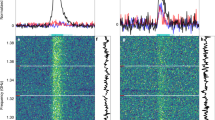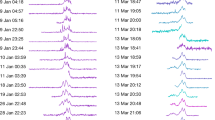Abstract
PREVIOUS observations of the radio source 3C273 by the method of lunar occultations have shown that it consists of two separate components the positions of which were determined with an accuracy of 1 arc sec1. Component A coincides closely with a jet-like nebulosity and component B with a nearby object of stellar appearance2. This communication presents a contour map of the source, constructed from the analysis of five complete occultations.
This is a preview of subscription content, access via your institution
Access options
Subscribe to this journal
Receive 51 print issues and online access
$199.00 per year
only $3.90 per issue
Buy this article
- Purchase on Springer Link
- Instant access to full article PDF
Prices may be subject to local taxes which are calculated during checkout
Similar content being viewed by others
References
Hazard, C., Mackey, M. B., and Shimmins, A. J., Nature, 197, 1037 (1963).
Schmidt, M., Nature, 197, 1040 (1963).
von Hoerner, S., Astrophys. J., 140, 65 (1964).
Scheuer, P. A. G., Austral. J. Phys., 15, 333 (1962).
Bailey, J. A., Branson, N. J. B. A., Elsmore, B., and Scheuer, P. A. G., Nature, 201, 755 (1964).
Conway, R. G., Haslam, C. G. T., Kronberg, P. P., and Slater, C. H., Nature, 201, 756 (1964).
Author information
Authors and Affiliations
Rights and permissions
About this article
Cite this article
HUGHES, M. Radio Brightness Contours of 3C273. Nature 207, 178–179 (1965). https://doi.org/10.1038/207178a0
Issue Date:
DOI: https://doi.org/10.1038/207178a0
This article is cited by
-
Radio brightness distribution of 3C273
Nature (1975)
-
Brightness Distribution and Polarization of 3C 273
Nature Physical Science (1972)
-
A High-Resolution Study of the Radio Source 3C273
Nature (1966)
Comments
By submitting a comment you agree to abide by our Terms and Community Guidelines. If you find something abusive or that does not comply with our terms or guidelines please flag it as inappropriate.



